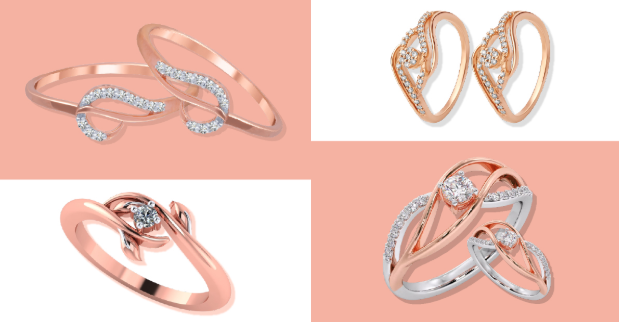What Is Rose Gold and How Is It Different from Yellow or White Gold?

Gold has captivated civilizations for millennia, symbolizing wealth, power, and timeless beauty. Over time, as craftsmanship and artistry evolved, gold was alloyed with other metals to create variations like yellow gold, white gold, and rose gold. Among these, rose gold has garnered immense popularity for its unique color and romantic appeal. But what is rose gold, and how is it different from yellow or white gold? Understanding these differences can help you make informed decisions, whether you’re purchasing jewelry or considering gold loan finance options. Let’s dive into the details of rose gold, its composition, and how it stands apart from its counterparts.
What Is Rose Gold?
Rose gold is an alloy made by combining pure gold with copper and, in some cases, silver. This answers the question what is rose gold, describing how the addition of copper gives rose gold its distinctive reddish-pink hue, setting it apart from yellow gold and white gold. Pure gold (24-karat gold) is naturally bright yellow and too soft for everyday use in jewelry. As a result, it is combined with other metals to improve durability and create different colors.
The proportion of copper and silver in rose gold impacts the intensity of its pink hue. A higher copper content results in a deeper reddish color, while more silver creates a softer rose shade. Typical rose gold alloys are made with 75% pure gold and 25% copper and silver, resulting in 18-karat rose gold. Lower karat versions, such as 14-karat rose gold, have less pure gold and a stronger reddish appearance due to higher copper content.
Origins and Popularity of Rose Gold
Though rose gold’s unique color feels modern, its origins date back to the 19th century in Russia. It was popularly referred to as “Russian gold” for a time, where its use in fine jewelry first gained traction. Over the years, rose gold’s aesthetic charm spread globally, and it now ranks as one of the most sought-after metals in jewelry design.
Rose gold’s warm, romantic tone resonates particularly with engagement rings, wedding bands, and even watches. Its versatility also makes it suitable for pairing with other gemstones like diamonds, sapphires, and emeralds. Fashion houses and designers frequently opt for rose gold because of its stylish, vintage appeal.
How Is Rose Gold Different From Yellow Gold?
Yellow gold and rose gold differ primarily in their composition and appearance. Yellow gold is the natural color of pure gold and remains unchanged when mixed with small amounts of alloy metals like silver and copper. It is the traditional choice for gold jewelry and carries a sense of classic elegance.
- Color
- Rose Gold: Has a pinkish or reddish hue due to the added copper content. Its warmer, romantic tone distinguishes it from other types of gold.
- Yellow Gold: Retains the bright, golden yellow color of pure gold. The alloys used in yellow gold have minimal impact on its color.
- Durability
- Rose Gold: Copper makes rose gold more durable than yellow gold, as the metal is stronger and resistant to scratches. This makes rose gold an excellent option for everyday wear.
- Yellow Gold: While yellow gold is durable too, it can be slightly softer than rose gold, especially in higher karat options like 22 or 24 karats.
- Hypoallergenic Properties
- Rose Gold: May not be hypoallergenic due to the presence of copper, which can cause skin irritation for individuals allergic to the metal.
- Yellow Gold: Typically more hypoallergenic if mixed with neutral alloy metals like silver or platinum.
- Popularity
- Rose Gold: Rose gold is popular for its trendy and vintage aesthetic, especially in modern jewelry pieces. Its romantic feel makes it ideal for engagement rings and gifts.
- Yellow Gold: Yellow gold has been used traditionally in jewelry for centuries and remains a timeless classic.
How Is Rose Gold Different From White Gold?
White gold is another variation of gold alloy that has a distinctly silvery-white shine, thanks to the addition of metals like nickel, palladium, or platinum. Even though they’re crafted from the same base of pure gold, white gold and rose gold differ significantly in composition and appearance.
- Color
- Rose Gold: Rose gold features a soft, warm pink tone that is created by copper alloys. It’s ideal for those who prefer a romantic and vintage-inspired style.
- White Gold: White gold has a silvery-white sheen, created by alloying gold with metals like nickel or palladium. White gold is often coated with rhodium to enhance its white finish.
- Durability
- Rose Gold: Rose gold’s copper content makes it durable and suitable for long-term use. Unlike white gold, rose gold doesn’t require recoating.
- White Gold: Over time, white gold may fade or yellow, especially if its rhodium coating wears off. Regular maintenance is necessary to restore its white appearance.
- Maintenance
- Rose Gold: Requires minimal upkeep and does not tarnish easily. Its natural patina may deepen over time, adding character to the jewelry.
- White Gold: Requires regular polishing and recoating to maintain its silvery-white finish.
- Hypoallergenic Properties
- Rose Gold: Contains copper, which can trigger allergies in some people.
- White Gold: Due to its nickel content, white gold can also trigger allergic reactions. However, hypoallergenic alternatives mixed with palladium or platinum are available.
- Price
- Rose Gold and White Gold: Both types are priced similarly for the same karat value due to their composition, although white gold with rhodium coating may incur additional costs for maintenance.
Comparing Gold Types: Which Suits Your Needs?
Every type of gold has its unique benefits. Choosing between rose gold, yellow gold, or white gold depends on your personal style, skin tone, maintenance preferences, and intended use. Here are some tips to help you decide:
- For a Romantic Look: Rose gold’s warm tone makes it ideal for engagement rings and gifts symbolizing love and affection.
- For a Traditional Feel: Yellow gold remains the classic choice for traditional jewelry such as wedding bands and heirlooms.
- For a Modern Aesthetic: White gold’s silvery shine complements contemporary styles and is a great alternative to platinum for sleek, modern designs.
Additionally, keep in mind that your choice in gold alloy could play a role in determining future decisions regarding gold loan finance. Certain alloys, such as 22-karat yellow gold, may have higher resale value or acceptability during gold loan evaluations due to their purer composition compared to 14-karat rose or white gold jewelry.
Understanding Gold Loan Finance: An Important Consideration
Gold isn’t just a symbol of luxury—it’s also a tangible asset that can provide financial security. Gold loan finance allows individuals to leverage their gold holdings, including rose gold, yellow gold, and white gold jewelry, for short-term loans during financial emergencies.
Here’s how gold loan finance works:
- Collateral-Based Loan: Gold jewelry is offered as collateral to a lender, who provides a loan amount based on the purity, weight, and value of the gold.
- Quick Approval: Since gold serves as the underlying asset, gold loans are approved quickly and require minimal documentation.
- Repayment Options: Borrowers repay the loan in installments along with interest, reclaiming their gold after full repayment.
For those who prefer rose gold or other alloys, it’s important to remember that the purity of gold (karat value) often influences the loan approval process. Higher-karat gold items typically fetch higher loan amounts due to higher gold content. If you plan to use your gold jewelry for financing purposes, ensure that the purity and weight are accurately assessed.
Why Rose Gold is a Timeless Choice
Whether you’re drawn to the romantic gleam of rose gold or its durability and contemporary charm, this alloy offers a unique alternative to traditional yellow and white gold. Its ability to pair beautifully with a variety of gemstones and settings makes rose gold ideal for expressing individuality. Moreover, even as trends shift with time, rose gold retains its timeless allure.
Yet, beyond its aesthetic appeal, rose gold serves as a valuable financial asset. If you ever find yourself in need of gold loan finance, your rose gold jewelry could serve as collateral, helping you achieve financial stability while preserving the intrinsic value of your investment.
Conclusion
Rose gold has emerged as a fashionable and timeless choice for jewelry lovers worldwide. Its pinkish hue, striking beauty, and durability make it a standout alternative to the traditional yellow or white gold options. Each gold alloy has distinct qualities that cater to varied tastes and requirements, from color and composition to maintenance and longevity.
Moreover, gold’s appeal doesn’t just rest in its beauty; its financial flexibility in the form of gold loan finance makes it a smart investment. Whether your jewelry is rose gold, yellow gold, or white gold, it holds intrinsic value that can provide critical financial support during emergencies.
The choice between rose gold and other gold types ultimately depends on personal preferences, lifestyle, and how you intend to use the jewelry—not just as an accessory but also as a potential financial asset. So the next time you’re deciding on gold jewelry, consider all the factors that set rose, yellow, and white gold apart. Rose gold, with its romantic and stylish flair, is more than just an alloy—it’s a symbol of love and individuality that transcends generations.




